Wave Behavior - Complete Toolkit
Objectives
- To predict how alterations in the medium through which a wave is traveling will affect the properties of that wave such as wavelength and speed.
- To predict the orientation of the reflected pulse at the boundary between two media and at a free-end and a fixed-end.
- To recognize the distinction between constructive and destructive interference and to use the principle of superposition to construct the resultant waveform from the two interfering waves.
- To describe the Doppler effect phenomenon and to explain its cause using words, diagrams, and formulas.
- To describe the phenomenon of wave reflection, refraction, and diffraction; to explain when each of these variables occur and to discuss the variables that affect the degree to which they occur.
Readings from The Physics Classroom Tutorial
- The Physics Classroom Tutorial, Waves Chapter, Lesson 3
http://www.physicsclassroom.com/class/waves/Lesson-3/Boundary-Behavior
Interactive Simulations
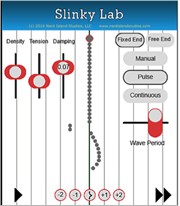 Physics Classroom: Slinky Lab Interactive
Physics Classroom: Slinky Lab Interactive
Our mobile-friendly Slinky simulation offers a host of ways to explore vibrations and wave behavior. Use the interactive tools to investigate how frequency, tension, and density affect the vibrational motion of particles and the speed of a transverse wave as it moves through a medium. Manually create a wave or select auto-generated continuous waves. You can choose open-end or fixed-end and adjust the period of the wave.
Note: We also created a Student Exercise specifically to accompany the Slinky Lab Interactive. Here’s the link: Student Exercise: Slinky Lab
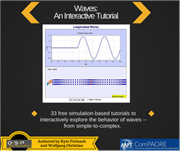 Waves: An Interactive Tutorial
Waves: An Interactive Tutorial
Here you’ll find a set of 33 simulation-based interactive tutorials designed to teach the fundamentals of waves. The project was sponsored by the American Association of Physics Teachers, and authored by physics professors Wolfgang Christian and Kyle Forinash. It starts with very simple wave properties and progresses to an examination of nonlinear wave behavior. Topics include wave superposition, interference, Fourier analysis, boundary behavior, impedance, diffraction, Doppler Effect, and more.
Teachers: The entire collection is available in ready-to-run HTML5 format, with question sets for each activity.
 PhET: Wave on a String
PhET: Wave on a String
This HTML5 activity simulates the motion of a vibrating string. Students can generate pulses manually or click “Oscillator” and let the simulation create traveling or standing waves. The string is modeled as a series of interacting masses. The tension of the string, damping, and frequency and amplitude of the oscillator can be adjusted. Choose a fixed, loose, or open end. The ruler tool makes it easy to measure wavelength.
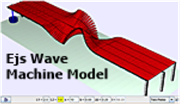 Wave Machine Model
Wave Machine Model
For a great multimedia exploration, we suggest this Java simulation from Open Source Physics, coupled with historic 1959 video of John Shive demonstrating his iconic wave-generating machine. The model was constructed to simulate Shive’s wave machine, consisting of horizontal cross-bars welded to a central wire spine perpendicular to the bars. The spine was constructed so it can freely twist, allowing the cross-bars to produce wave patterns. The simulation lets students select a function for the twist of the first rod, or manually drag the first rod. You can choose a free or fixed end and change the bar length.
Teachers: Although it’s Java, the simulation opens easily in all major browsers. To view Dr. Shive’s 25-minute demonstration, click this link: John Shive: Similarities of Wave Behavior
Video and Animations
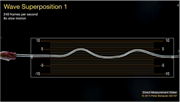 Direct Measurement Video: Wave Superposition
Direct Measurement Video: Wave Superposition
What happens when two waves overlap in the same medium? Do they reflect off each other or pass through each other? Do they add or subtract? These high-resolution videos allow students to make observations to explore the conditions that govern wave superposition. Three videos are included: 1) Two waves of the same phase and ~ same amplitude, 2) Two waves of opposite phase and ~ same amplitude, and 3) Two waves of opposite phase and different amplitudes. Teachers: Direct Measurement Videos are considered to be evidence-based best practice for analysis of physical phenomena in the context of mathematical relationships. For more information on this pedagogical approach, click this link: Why Teach with Direct Measurement Videos?
 Direct Measurement Video: Wave Reflection
Direct Measurement Video: Wave Reflection
How do waves reflect from barriers? This resource provides high-resolution videos of waves reflecting from both fixed and free ends. The slow-motion feature allows students to see how a wave is affected by either type of reflection. Vertical and horizontal measurement tools are also provided to allow calculation. Teachers: Direct Measurement Videos are considered to be evidence-based best practice for analysis of physical phenomena in the context of mathematical relationships. For more information on this pedagogical approach, click this link: Why Teach with Direct Measurement Videos?
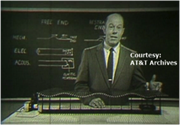 Similarities of Wave Behavior
Similarities of Wave Behavior
We really like this historic 1959 video, available from the AT&T Archives. It shows physicist John Shive demonstrating his iconic Wave Machine, a system consisting of horizontal cross-bars welded to a central wire spine. It’s not just the ingenious model we like, it’s Dr. Shive’s great way of explaining how “waves of all kinds behave fundamentally alike”. The machine shows wave reflection, superposition, and impedance as Dr. Shive explains how each of these behaviors is manifested in mechanical waves, E&M waves, and acoustical tubes. The language is easy to understand, and the calculations are simple to follow, even for beginners.
 ZonaLand Education: Wave Adder
ZonaLand Education: Wave Adder
This animated activity lets students explore wave interference interactively as they set values for amplitude, frequency, and phase shift to draw two waves. Click “Add Yellow to White” to see the sum of the waves that have been added. Note to Teachers: The “sum” is not displayed numerically, but rather as the pattern of the waves at the point of interference. For example, adding a wave with a frequency of 1 to a wave with a frequency of -1 will result in a blank screen (they cancel each other). The animation can display sine or cosine functions. Great way to explore wave interference!
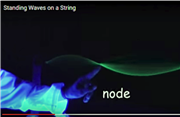 UCLA Physics Videos: Standing Waves on a String
UCLA Physics Videos: Standing Waves on a String
Join physics teacher James Lincoln as he puts on a very visual display to demonstrate that standing waves really aren’t “standing” at all. Using fluorescence and strobe lights with a standing wave maker machine, Lincoln takes you from 1st through 5th harmonics to show the nature of nodes and antinodes. He introduces the mathematical ratio for calculating wavelength of a harmonic. Teachers: Standing waves are produced when two waves of identical frequency interfere with one another while traveling in opposite directions along the same medium.
Physics Education Research
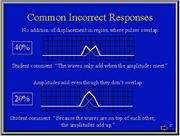 Student Difficulties with Wave Concepts, by Michael C. Wittman
Student Difficulties with Wave Concepts, by Michael C. Wittman
This presentation by Michael Wittman of the Physics Education Research Laboratory shows results of a research study on misconceptions held by students about wave mechanics and motion. The results indicate that many students have incorrect mental models of waves and use these erroneous models to interpret problems related to wave mechanics. The presentation also tested instructional methods to help students overcome their difficulties.
Labs and Investigations
- The Physics Classroom, The Laboratory, Wave Behavior Demonstration Lab
This lab involves a demonstration of the various types of wave behaviors using available classroom demonstration materials.
Link: http://www.physicsclassroom.com/lab#waves
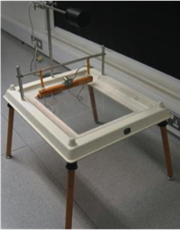 Practical Physics: Ripples Crossing-Interference
Practical Physics: Ripples Crossing-Interference
In this resource sponsored by the UK’s Institute of Physics, you’ll find a set of four classroom ripple tank experiments for exploring what happens when pulses and waves pass through each other. It’s a standout resource because the directions are clear and simple enough for students to follow, it contains explicit safety precautions, and tips for teachers in setting up stroboscopes, recognizing nodal line patterns, and measuring maxima/minima.
Link: http://practicalphysics.org/ripples-crossing-interference.html
Demonstration Ideas
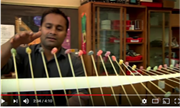 National STEM Centre: Wave Machine Demonstration
National STEM Centre: Wave Machine Demonstration
Want to build your own wave machine? This cool video, produced by the UK’s National STEM Centre, shows how to do exactly that with gummi candies, duct tape, and kabob sticks. It might not rival the Shive Wave Machine, but it could be a really useful tool to demonstrate wave behavior in your classroom. You can model wave reflection, transfer of energy in a wave, and changing wave speed. Cheap and easy to assemble in 20 minutes or less!
 PhET Teacher-Created Activities: Wave Clicker Questions
PhET Teacher-Created Activities: Wave Clicker Questions
This is an exemplary set of 60+ clicker questions (with answer key) for use in a Wave Unit for introductory physics. It was authored by veteran HS physics teacher Trish Loeblein specifically to accompany PhET simulations related to wave behavior. It covers wave reflection, interference, frequency and wave speed, boundary behavior, reflection and lenses, and resonance. Pick and choose what you need to support your own unit! Note to Teachers: You must be a registered user of PhET to access this resource. Registration is free and the resource itself is freely accessible in either HTML or as a downloadable PowerPoint. The answer key is in the ppt version.
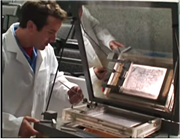 UCLA Physics Videos: Light Wave Diffraction
UCLA Physics Videos: Light Wave Diffraction
James Lincoln uses a wave tank system that reflects illuminated plane waves onto a projection screen. You can see the plane waves before they diffract, then watch their boundary behavior with a double-slit barrier (they diffract). Lincoln then shows the projected display of laser light through the double slit. Last, Lincoln demonstrates the patterns that occur when light is diffracted through human hair, a single slit, a diffraction grating, and the space between your fingers.
Minds On Physics Internet Modules:
The Minds On Physics Internet Modules are a collection of interactive questioning modules that target a student’s conceptual understanding. Each question is accompanied by detailed help that addresses the various components of the question.
- Wave Motion Module, Ass’t WM5 - Boundary Behavior of Waves
- Wave Motion Module, Ass’t WM6 - Interference of Waves
- Sound and Music Module, Ass’t SM4 - The Doppler Effect
Concept Building Exercises:
- The Curriculum Corner, Wave Basics, Boundary Behavior of Waves
- The Curriculum Corner, Wave Basics, Interference of Waves
- The Curriculum Corner, Sound and Music, The Doppler Effect
Real Life Connections:
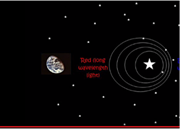 Red Shift and Doppler Effect
Red Shift and Doppler Effect
Understanding the Doppler Effect makes it easier to understand redshift. Redshift occurs when light or electromagnetic waves increase in wavelength and are “shifted” to the red end of the spectrum. A redshift occurs when a light source moves away from an observer, analogous to the way sound waves from a receding ambulance siren “stretch out” from the reference frame of a stationary observer (Doppler effect). The theory of expansion of the universe relies on calculations of the cosmological redshift of distant light sources. If the source of light is moving away from the observer, then redshift occurs. The phenomenon is well explained in this short YouTube video.
Content Support for Teachers:
 Light and Matter: Vibrations and Waves
Light and Matter: Vibrations and Waves
This page is Volume 3 of the digital textbook Light and Matter by physicist Benjamin Crowell. It would be a great choice for teachers wanting a refresher or desiring a deeper dive into the physics of vibrations and waves. It’s chock full of real-life examples of wave and vibrational phenomena, such as the spider draglines pictured above, the physics of water waves, and an entire section on the Tacoma Narrows Bridge collapse. Every concept is supplemented with charts, images, and diagrams to promote understanding. The writing style is engaging and concepts are well-integrated across multiple constructs.
Common Misconception:
- The Meeting of Waves
The meeting up of two waves while traveling in opposing directions along the same medium is called interference. It is a common student misconception that the waves meet, interfere, and then bounce back to where they originated. The truth is quite different than this. Once two waves meet they continue to travel in the same original direction; they do not bounce off each other. Rather, they pass through each other and are not altered by the interference process. To convince students of this truth, perform a interference demonstration with two pulses heading in opposite directions along the same medium. One pulse can be displaced upward and the other downward; or one can be of high amplitude and the other of low amplitude. This allows students to distinguish between the interfering pulses. They will be able to observe that there is no bouncing off of each other; the pulses continue in their original direction.
Standards:
A. Next Generation Science Standards (NGSS)
Performance Expectation: High School Physical Science - Waves
- HS-PS4-1: Use mathematical representations to support a claim regarding relationships among the frequency, wavelength, and speed of waves traveling in various media.
Disciplinary Core Ideas: Physical Science - Waves
- Wave Properties: HS-PS4.A.iii: Waves can add or cancel one another as they cross, depending on their relative phase (i.e., relative position of peaks and troughs of the waves), but they emerge unaffected by each other.
Crosscutting Concepts
Patterns
- Different patterns may be observed at each of the scales at which a system is studied and can provide evidence for causality in explanations of phenomena.
Science and Engineering Practices
Practice #1: Analyzing and Interpreting Data
- Analyze data using tools, technologies, and/or models (e.g., computational, mathematical) in order to make valid and reliable scientific claims.
Practice #3: Constructing Explanations
- Construct an explanation based on valid and reliable evidence obtained from a variety of sources (including students’ own investigations, models, theories, simulations) and the assumption that theories and laws that describe the natural world operate today as they did in the past and will continue to do so in the future.
Practice #4: Developing and Using Models
- Use a model to provide mechanistic accounts of phenomena.
- Develop and use a model based on evidence to illustrate the relationships between systems or between components of a system.
Practice #8: Using Mathematics and Computational Thinking
- Use mathematical representations of phenomena to describe explanations.
- Use mathematical models and/or computer simulations to predict the effects of a design solution on systems and/or interactions between systems.